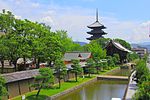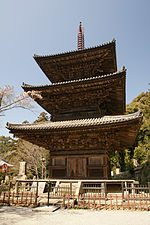the three most important Zenshūyō buildings. Kōzan-ji's butsuden (built in 1320) is the oldest extant building in the Zenshūyō style in Japan. At the end...
11 KB (1,321 words) - 11:22, 19 February 2024
elements evolved into the Zenshūyō style, seen later on in the Kamakura period. This style utilizes the "hidden roof" innovation. Zenshūyō style temples, such...
13 KB (1,542 words) - 02:17, 28 June 2024
in Zenshūyō (禅宗様) (aka Zen'yō) style (Zen style), combining Japanese and Chinese design features. It is the oldest building designed in the Zenshūyō style...
2 KB (138 words) - 21:00, 15 August 2021
important Buddhist architectural styles in Japan along with Daibutsuyō and the Zenshūyō, which were developed based on Chinese architectural styles from the Kamakura...
5 KB (553 words) - 04:25, 22 September 2023
elements from three different antecedent styles: wayō, daibutsuyō, and zenshūyō. It is exemplified by the main hall at Kakurin-ji. The combination of wayō...
2 KB (141 words) - 20:09, 30 October 2023
emerged in the late 12th or early 13th century. Together with Wayō and Zenshūyō, it is one of the three most significant styles developed by Japanese Buddhism...
8 KB (932 words) - 20:54, 20 April 2024
below), extending laterally the support provided by the system. Wayō-, Zenshūyō- and Daibutsuyō-style tokyō all differ in details, the first being the...
11 KB (1,380 words) - 05:11, 12 March 2024
architecture, creating the Daibutsuyō and Zenshūyō styles. The Wayō style was combined with Daibutsuyō and the Zenshūyō to create the Shin-Wayō and the Setchūyō...
91 KB (11,219 words) - 17:08, 18 July 2024
mikkyō sects Tendai and Shingon Buddhism. The Daibutsuyō style and the Zenshūyō style emerged in the late 12th or early 13th century. The following Japanese...
98 KB (11,795 words) - 06:32, 29 July 2024
the Amida Hall at Jōdo-ji are the only extant examples of this style. Zenshūyō – A style that takes its name from its creators, the Buddhist Zen sect...
48 KB (6,034 words) - 23:15, 26 April 2024
space. This effect results from the lower roof mokoshi. This is called Zenshūyō. This style can be seen at Shariden of Enkaku-ji in Kamakura. For example...
8 KB (897 words) - 05:57, 8 October 2023
Shingon, and coined in the Kamakura period to distinguish it from the newer zenshūyō and daibutsuyō styles of architecture. The pagoda is 3x3 ken, and has a...
13 KB (1,205 words) - 02:09, 28 June 2024
shingles rather than roof tiles. Some parts of the building are in the zenshūyo, with Chinese influence, including the inverted lotus-shaped ornaments...
7 KB (708 words) - 03:42, 7 June 2024
Yakhchāl Yalı Yaodong Yeseria Yett Z-plan castle Zakopane Style Zarih Zellige Zenshūyō Zero carbon housing Zero-energy building Zingel Zoomorphic architecture...
65 KB (5,416 words) - 20:57, 2 August 2024
albeit in a purely decorative role, and are typical of the Wayō style. The Zenshūyō style used by Zen temples has instead bracket complexes even between posts...
5 KB (513 words) - 19:21, 25 August 2022
Master Zendo Zeni Zengakuren Zenjibu-ji Zenkō-ji Zenkō-ji (Gifu) Zenshō-an Zenshūyō Zensui-ji Zentsūji, Kagawa Zeon Zero Wing Zeta Gundam Zoids Zōjō-ji Zone...
8 KB (758 words) - 00:45, 14 June 2024
Also, although all extant Zen temples have it, it is likely that the Zenshūyō style, which arrived roughly at the same time of the Daibutsuyō, adopted...
8 KB (1,015 words) - 07:48, 1 May 2023
architecture, as they include features of all major styles, that is Daibutsuyō, Zenshūyō and Wayō. The honden, which shows strong daibutsuyō influences, is extremely...
5 KB (583 words) - 05:31, 14 November 2023















